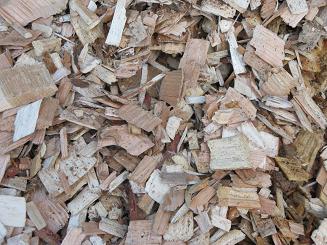The emergence of new markets for hardwoods as raw material for biofuels is likely to exacerbate limitations on hardwood availability. Eucalyptus may offer new options for quickly producing hardwood fiber. Take a look!
Paper mills that require hardwoods as raw material often have difficulty in acquiring sufficient supplies of local trees when conditions are wet. Much of the hardwood trees mills rely on grow in bottomland areas that cannot be harvested during wet periods in order to protect soil and water quality. When mills cannot obtain enough local trees, they must bring in chips by rail and/or barge at high expense. The emergence of new markets for small-diameter hardwoods as raw material for biofuels such as wood pellets is likely to exacerbate limitations on hardwood availability. To overcome these hardwood supply problems, forest managers need new options for quickly growing plantations of hardwoods, preferably on upland soils that provide a wider harvesting window.
Eucalyptus plantations have the potential to boost the hardwood production potential in portions of the southeastern U.S. Under proper management, eucalyptus grows rapidly, is resistant to disease and insects, and has wood properties highly desired for multiple uses. Eucalyptus has excellent fiber properties for paper, engineered and reconstituted wood products, and bio-product industries. When pelletized and direct-fired in a power plant, eucalyptus has heat energy values that exceed many native tree species. Eucalyptus plantations can reach a harvestable size (up to 70 ft. in height and 7 inches in DBH) for pulpwood or biofuel in as little as 6 to 8 years. Under proper management, eucalyptus has the ability to produce 20 green tons per acre per year. This growth rate compares favorably to the commonly planted loblolly pine, which produces up to 8 tons per acre per year. Eucalyptus plantations can achieve these high growth rates on upland soils, which may provide the forest products industry with a greater supply of hardwood trees grown relatively close to paper and biofuel production facilities.
Eucalyptus is one of the largest genera of trees and shrubs in the world. A native primarily to Australia, the genus includes more than 700 individual species, a handful of which are among the fastest-growing trees in the world. Eucalyptus is grown in many countries as a short-rotation pulpwood feedstock. As a result, much of the world’s paper of hardwood origin contains eucalyptus. However, most eucalypts are intolerant of frost, or only tolerate light frosts down to about 27°F (–3 °C). This susceptibility to cold damage has historically restricted the viability of eucalyptus plantation management in much of the U.S. Tree breeding research has recently identified cold-resistant eucalyptus trees. These trees are tolerant of temperatures down to 17°F (–8 °C). This cold tolerance makes eucalyptus plantation management viable in southern portions of most states in the southeast U.S.
As a result of the identification of cold-tolerant eucalyptus, the forest products industry is beginning to plant some eucalyptus plantations. For example, there are approximately 3,000 acres of eucalyptus plantations throughout southwest Louisiana and southeast Texas. The industry in that region plans to increase eucalyptus plantations by 1000 to 1500 acres per year in upcoming years. This planting effort has the potential for new income opportunities for landowners in that region. Some landowners are planting eucalyptus to market as pulpwood in 6 to 8 years. Other landowners have entered leases in which a forest product company commits to paying the landowner annual land rental payments. In these lease agreements, which last typically 10 years, the forest product company will incur all plantation establishment, management, and harvesting costs. After the eucalyptus plantation is harvested at the end of an 8-year rotation, there is the potential for landowners to receive pulpwood revenue after the lease ends because the trees will re-sprout and reach pulpwood size in another 4 to 8 years. However, to have a quality pulpwood stand from re-sprout origin it is often necessary for landowners to take measures to reduce the number of sprouts per stump soon after the plantation is harvested.
Eucalyptus plantations must be intensively managed to become established and reach its yield potential. Prior to planting, mechanical and chemical site preparation is essential. Roots of eucalyptus are easily restricted, so sites must be subsoiled and bedded to improve root development. Chemical site preparation is dependent on post-harvest vegetation growth, but generally includes a summer broadcast application of broad-spectrum herbicides. Eucalyptus seedlings are planted in the fall as container seedlings so they can adapt to the site environment prior to the first frost. In order for eucalyptus to achieve the desired growth in the first and second year, it is essential that near-complete suppression of grasses, broadleaf weeds, and hardwood sprouts is achieved. Current operational protocol consists of directed spray of glyphosate herbicide by backpack sprayers multiple times during the first and second years of the rotation, with the first application each year occurring in early spring. Research is underway to reduce this cost of eucalyptus plantation management, and results have identified alternative herbicides that can be applied fewer times and at less expense relative to glyphosate. Fertilization with phosphorus as 150 to 200 lbs. of triple superphosphate per acre is needed in the first growing season on many sites to promote optimum growth of eucalyptus. A second fertilization with nitrogen as 150 to 200 lbs. of urea per acre is also needed after crown closure at age 3 to 4 years.
Eucalyptus plantation management is a new practice in the southeastern U.S., and research efforts to reduce its costs and monitor its environmental impact accompany the emergence of this practice. The forest product industry faces the challenges of sustaining markets for traditional forest products and fostering the development of new biofuel markets, and eucalyptus plantations capable of incredible growth may become a tool to help overcome these challenges.


